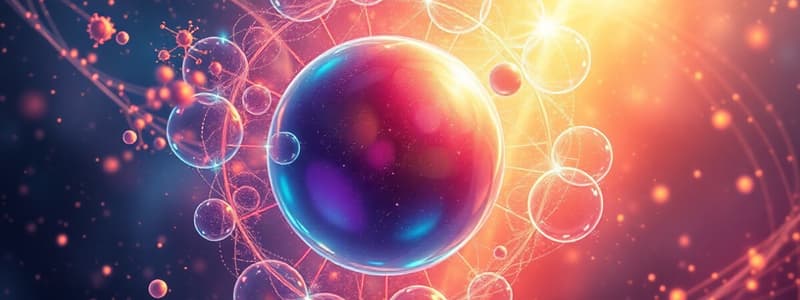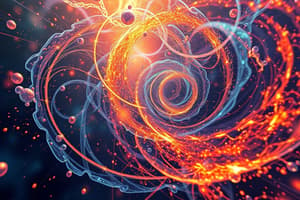Podcast
Questions and Answers
What is the relationship between wavelength and frequency of light?
What is the relationship between wavelength and frequency of light?
- Shorter wavelengths correspond to higher frequencies. (correct)
- Wavelengths and frequencies are unrelated.
- Shorter wavelengths correspond to lower frequencies.
- Wavelengths are directly proportional to frequencies.
How is the energy of a light wave related to its frequency?
How is the energy of a light wave related to its frequency?
- It is inversely proportional to its frequency.
- It quadruples with increased frequency.
- It is unrelated to its frequency.
- It is directly proportional to its frequency. (correct)
Which color of visible light has the longest wavelength?
Which color of visible light has the longest wavelength?
- Blue light
- Violet light
- Red light (correct)
- Green light
What does the equation E=hf calculate?
What does the equation E=hf calculate?
Which statement correctly describes how energy changes along the electromagnetic spectrum?
Which statement correctly describes how energy changes along the electromagnetic spectrum?
Which of the following statements reflects wave-particle duality?
Which of the following statements reflects wave-particle duality?
What is the frequency of light measured in?
What is the frequency of light measured in?
As you move from radio waves to gamma rays in the electromagnetic spectrum, how does their energy change?
As you move from radio waves to gamma rays in the electromagnetic spectrum, how does their energy change?
What is the maximum number of electrons that can occupy a single s orbital?
What is the maximum number of electrons that can occupy a single s orbital?
Which of the following correctly defines Hund’s Rule?
Which of the following correctly defines Hund’s Rule?
According to the Aufbau principle, how should electrons be added to atomic orbitals?
According to the Aufbau principle, how should electrons be added to atomic orbitals?
In an orbital diagram, what does a single arrow represent?
In an orbital diagram, what does a single arrow represent?
Which of the following represents the correct full electron configuration for Calcium (Ca)?
Which of the following represents the correct full electron configuration for Calcium (Ca)?
What is the short form notation for Calcium using the noble gas core?
What is the short form notation for Calcium using the noble gas core?
According to the Pauli exclusion principle, what is true about electrons in the same orbital?
According to the Pauli exclusion principle, what is true about electrons in the same orbital?
How many p orbitals exist in each p sublevel?
How many p orbitals exist in each p sublevel?
How does temperature affect the motion of particles in a substance?
How does temperature affect the motion of particles in a substance?
What does kinetic energy measure?
What does kinetic energy measure?
What is the strongest type of inter-particle force?
What is the strongest type of inter-particle force?
Which of the following statements is true regarding the phases of matter?
Which of the following statements is true regarding the phases of matter?
What happens to the kinetic energy of a substance as it cools?
What happens to the kinetic energy of a substance as it cools?
What is heat defined as?
What is heat defined as?
Which type of inter-particle force is typically the weakest?
Which type of inter-particle force is typically the weakest?
How is temperature related to the average kinetic energy of a substance?
How is temperature related to the average kinetic energy of a substance?
What is the percent abundance of the Ag-107 isotope?
What is the percent abundance of the Ag-107 isotope?
Which step in the mass spectrometry process involves giving the atoms a positive charge?
Which step in the mass spectrometry process involves giving the atoms a positive charge?
In the context of relative atomic mass calculations, what does 'm/z' stand for?
In the context of relative atomic mass calculations, what does 'm/z' stand for?
Why is it important for the sum of the percent abundances of isotopes to equal 100%?
Why is it important for the sum of the percent abundances of isotopes to equal 100%?
What does the relative height of each peak in a mass spectrum indicate?
What does the relative height of each peak in a mass spectrum indicate?
What is the percentage abundance of Chlorine-35 in the given sample?
What is the percentage abundance of Chlorine-35 in the given sample?
Which combination of isotopes produces a mass of 71.935 when two chlorine atoms bond?
Which combination of isotopes produces a mass of 71.935 when two chlorine atoms bond?
How is the probability of forming Cl-35Cl-37 calculated?
How is the probability of forming Cl-35Cl-37 calculated?
What is the total relative abundance when combining Chlorine-35 and Chlorine-37?
What is the total relative abundance when combining Chlorine-35 and Chlorine-37?
What is the mass of the molecule formed by two Chlorine-37 isotopes?
What is the mass of the molecule formed by two Chlorine-37 isotopes?
What mathematical operation is used to find the percentage abundance from relative abundance?
What mathematical operation is used to find the percentage abundance from relative abundance?
Which of the following values represents the probability of forming Cl-35Cl-35?
Which of the following values represents the probability of forming Cl-35Cl-35?
What is the first step in determining the isotopic composition from the given data?
What is the first step in determining the isotopic composition from the given data?
Study Notes
Kinetic Molecular Theory
- The amount of kinetic energy is proportional to the temperature of the substance.
- The faster the particles move, the less they can be contained.
- As substances are heated, KMT and energy increase, which can change the state of matter.
- If a substance cools, KMT reduces and therefore it could turn into a solid.
- Kinetic energy is the energy of motion.
- Kinetic energy is dependent on temperature and measured in Joules.
- Temperature is proportional to the average amount of kinetic energy a substance has.
- Temperature is independent of mass and measured in degrees.
- The amount of KE each particle has in a given sample will vary, therefore temperature is the average KE.
- Heat is the amount of thermal energy transferred from one object to another.
- Heat is dependent on mass and measured in Joules.
Inter-particle Forces
- Refers to the forces of attraction or repulsion between particles (atoms, molecules, or ions) in a substance.
- These forces determine the physical properties of a material, such as its phase (solid, liquid, or gas), melting and boiling points, and solubility.
- Van der Waals forces are the weakest and are attractions between molecules due to temporary dipoles.
- Dipole-dipole interactions are attractions between polar molecules with permanent dipoles.
- Hydrogen bonding is a strong dipole-dipole interaction involving hydrogen bonded to nitrogen, oxygen, or fluorine.
- Ionic bonds are the strongest and are attractions between positively and negatively charged ions.
States of Matter
- Solid (s): A substance in its solid state has a definite shape and volume, with its particles closely packed in a fixed arrangement.
- Liquid (l): A substance in its liquid state has a definite volume but takes the shape of its container.
Isotopes
- Silver has two naturally occurring isotopes: 107Ag and 109Ag.
- The relative atomic mass of silver is 107.87.
- The percent abundance of each isotope can be calculated using the average atomic mass equation:
- Average atomic mass = (% of isotope 1 x mass of isotope 1) + (% of isotope 2 x mass of isotope 2)
Mass Spectrometry
- A mass spectrometer is used to determine the relative atomic masses of elements using their isotopic composition.
- It works by: vaporizing, ionizing, accelerating, and detecting the sample.
- The ions produced are sorted and detected by their mass/charge (m/z) ratio.
- The relative height of each peak corresponds to the abundance of each isotope in the sample tested, based on its m/z ratio.
- The ratio of each peak, relative to the total, can be used to calculate the percentage abundance of that isotope.
Emission and Absorption of Light
- Light, as a form of electromagnetic radiation, exhibits wave-particle duality.
- The electromagnetic spectrum includes a broad range of wavelengths, frequencies, and energies, from radio waves with long wavelengths to gamma rays with very short wavelengths.
- Wavelength refers to the distance between two consecutive peaks of a light wave and is measured in units such as meters, nanometers (nm), or micrometers (𝛍m).
- Frequency is the number of waves that pass a given point per second, measured in (Hz).
- Energy is directly proportional to its frequency and inversely proportional to its wavelength.
- Shorter wavelengths have higher frequencies and more energy, while longer wavelengths have lower frequencies and less energy.
- A photon carries a specific amount of energy, calculated using the equation E=hf, where E is energy, h is Planck’s constant (6.626 x 10⁻³⁴ J·s), and f is the frequency of the light.
- Visible light consists of different colors that correspond to specific wavelengths.
Electron Configuration
- Electron configuration notation is a way to communicate electron arrangement.
- The Aufbau principle states that electrons are added from low to high energy.
- Hund's rule states that an electron must be placed in each orbital of a sublevel before electrons can be paired.
- The Pauli exclusion principle states that electrons in the same orbital must have opposite spin, with a maximum of 2 electrons per orbital.
- Short form notation includes the previous noble gas in [ ] and then adds the rest.
- Orbital diagrams are arrow-in-box diagrams, used to represent the filling and relative energy of orbitals.
Studying That Suits You
Use AI to generate personalized quizzes and flashcards to suit your learning preferences.
Related Documents
Description
This quiz covers the Kinetic Molecular Theory (KMT), focusing on the relationship between kinetic energy, temperature, and the states of matter. It also explores inter-particle forces that affect the behavior of substances. Test your understanding of these core concepts in physics and chemistry.




